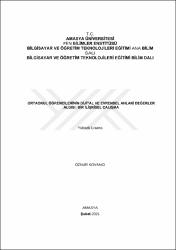Ortaokul öğrencilerinin dijital ve evrensel ahlaki değerler algısı: Bir ilişkisel çalışma

View/
xmlui.dri2xhtml.METS-1.0.item-rights
info:eu-repo/semantics/openAccessDate
2021Metadata
Show full item recordAbstract
Okullarda bireylerin değer yargılarının gelişmesine ve bireyin isteklerine uygun yaşam kurmasına yardımcı olması amacı ile değerler eğitimi verilmektedir. Bu eğitim öğrencilerin değer bilgilerini geliştiren, onlara beceriler kazandıran ve kazandıkları beceriler sayesinde toplumun bir parçası olmalarını sağlayan faaliyetler olarak tanımlanmaktadır. Günümüz teknolojisinin içine doğan ve bu teknoloji ile büyüyen çocuklar için değerlerin aktarımı da değişiklik göstermiştir. Bu bağlamda bu araştırmanın amacı, ortaokul öğrencilerinin dijital ortamdaki ahlaki değer algıları ile reel ortamdaki ahlaki değer algılarını belirlemek ve dijital ortamda ahlaki değer algıları ile reel ortamdaki ahlaki değer algıları arasında ilişki olup olmadığını ortaya çıkarmaktır. Bu çalışmada ilişkisel tarama modeli kullanılmıştır. Araştırmanın çalışma grubunu Tokat ve Amasya illerinde bulunan 7 farklı ortaokulda öğrenim görmekte olan toplam 1832 ortaokul öğrencisi oluşturmaktadır. Araştırma verileri "Ortaokul Öğrencilerinin Dijital Ortamda Ahlaki Değerlere Dönük Algıları Ölçeği" ve "10-13 Yaş Çocukları İçin Evrensel Ahlaki Değerler Ölçeği" kullanılarak toplanmıştır. Elde edilen veriler ile aritmetik ortalama, standart sapma, t-test, anova ve pearson r korelasyon katsayısı kullanılarak analizler yapılmıştır. Araştırma sonuçlarına göre; ortaokul öğrencilerinin dijital ortamda ahlaki değerlere dönük algı düzeyleri ve evrensel ahlaki değerlere dönük algı düzeyleri yüksek seviyede olduğu bulunmuştur. Kız öğrencilerin erkek öğrencilere göre dijital ortam ahlaki değer algı düzeyleri daha yüksek düzeyde ve sınıf düzeyinin ortaokul öğrencilerinin dijital ortam ahlaki değer algı düzeylerini etkilemediği sonucuna ulaşılmıştır. Ayrıca, internette daha fazla vakit geçiren ortaokul öğrencilerinin dijital ortam ahlaki değer algı düzeyleri daha yüksek ve çevrimiçi oyun oynayan ortaokul öğrencilerin çevrimiçi oyun oynamayan ortaokul öğrencilere göre dijital ortam ahlaki değer algı düzeyleri de daha yüksek düzeyde olduğuna ulaşılmıştır. Kız öğrencilerin erkek öğrencilere göre evrensel ahlaki değer algı düzeyleri daha yüksek olduğu, internette geçirilen süre artıkça ortaokul öğrencilerinin evrensel ahlaki değer algı düzeylerinin arttığı ve çevrimiçi oyun oynayan ortaokul öğrencilerin çevrimiçi oyun oynamayan ortaokul öğrencilerine göre evrensel ahlaki değer algı düzeylerinin daha yüksek olduğu sonucuna ulaşılmıştır. Öğrencilerin evrensel ahlaki değer algı düzeyleri artıkça dijital ortam ahlaki değer algı düzeylerinin de arttığı gözlenmiştir. Values education is given with the aim of to increase individuals' standard of judgment and to give them the opportunity to create a life maintained by preferences and expectations in school. This education is defined as activities that develop and increase students' valuable knowledge and offer them upskill their skills which enable them to become a part of the society.The transfer of values has also changed for children born into today's technology and growing up with this technology. In this sense this research purpose is to determine a difference between ethical value judgment of middle school students in the digital media and ethical value judgment in the real environment and to reveal whether there is a relationship between their moral value perceptions in the digital environment and their perception of moral values in the real environment. In this research correlational survey method was used. The study group of the research consists of 1832 secondary school students studying in 7 different secondary schools in Tokat and Amasya. The research data were collected by using the "Perceptions of Middle School Students Towards Moral Values in Digital Environment Scale" and "The Universal Moral Values Scale for 10-13 Years Old Children". Analysis of arithmetic mean, standard deviation, t-test, anova and pearson r correlation coefficient is conducted using the data obtained. According to the research results; level of middle school students' perception of moral values in the digital environment and perception towards universal moral values were found at a high level. Female students have a higher level of moral value perception in the digital environment than male students. In addition, it was concluded that the grade level did not affect the digital media moral value perception levels of middle school students. The digital environment increases the moral value perception levels of middle school students who spend more time on the Internet. As a result of the research, it was found that secondary school students who play online games have a higher level of digital media moral value perception compared to middle school students who do not play online games. In conclusion according to the research data, it was concluded that female students had higher perception levels of universal moral values than male students, secondary school students' level of perception of universal moral values increased as the time spent on the internet increased. Also it has been concluded that as the time spent on the internet increases, the level of perception of universal moral values of secondary school students increases and that the level of perception of universal moral values of middle school students who play online games is higher than that of middle school students who do not play online games.It was observed that as the students' level of perception of universal moral values increased, their level of moral value perception in digital environment also increased.
URI
https://tez.yok.gov.tr/UlusalTezMerkezi/TezGoster?key=9MiDp3x86xrwjpi5-14w-SnL_akOYg9-dF5U2XFGxJfHWkOFGYl_yF3L-c10F5gkhttps://hdl.handle.net/20.500.12450/1744
Collections
- Tez Koleksiyonu [397]

















